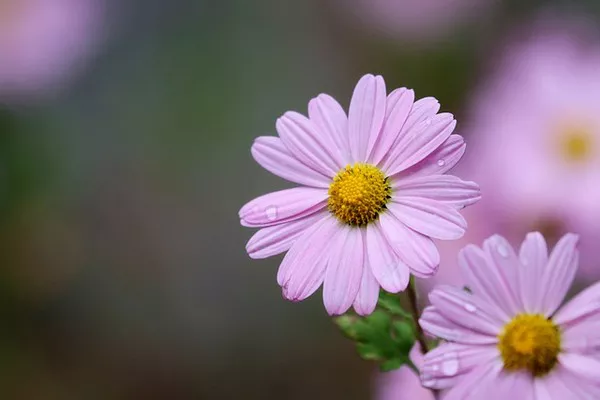Every month of the year is associated with a particular birth flower, and September is no exception. For those fortunate enough to be born in this month, the birth flower is the aster. Asters are not only beautiful but also carry significant symbolism and history. In this article, we will delve into the fascinating world of September’s birth flower, exploring its origins, meanings, and the cultural significance it holds.
The Aster: A Floral Marvel
Asters belong to the Asteraceae family, which includes over 600 species and is one of the largest families of flowering plants. These daisy-like flowers are known for their vibrant colors, intricate petals, and prominent yellow centers. Asters come in a variety of hues, including shades of purple, pink, blue, and white, making them a versatile and stunning addition to any bouquet or garden.
Origins of the Name
The name “aster” is derived from the Greek word “astron,” which means “star.” This name is a nod to the flower’s star-like appearance, with its radiating petals resembling the rays of a star. The Greeks believed that asters were created from stardust when the goddess Astraea wept over Earth’s lack of stars.
Asters in History and Mythology
Throughout history, asters have been celebrated and used for various purposes. In ancient times, they were used as love charms and believed to be sacred to the goddess Venus. In addition to their romantic associations, asters also held medicinal value. The ancient Greeks used them to create remedies for a variety of ailments, including digestive issues and snake bites.
Aster’s association with stars and the celestial world extended into mythology. As previously mentioned, the Greeks associated asters with Astraea, the goddess of innocence and purity, who eventually transformed into the constellation Virgo. This connection to purity and innocence has persisted over the centuries and contributes to the flower’s symbolic meaning.
Symbolism of the Aster
The aster holds a rich tapestry of symbolism, each layer adding depth to its significance. Some of the most prominent meanings associated with asters include:
Love and Affection: Asters are often seen as symbols of love and affection, making them popular choices for bouquets exchanged between lovers. Their radiant petals and pleasing scent convey feelings of deep emotion and adoration.
Patience: In the language of flowers, asters are also associated with patience and delicate feelings. The gradual unfurling of the aster’s petals represents the gradual development of deep emotions and the patience required to nurture a loving relationship.
Remembrance: Asters are sometimes chosen as flowers to remember loved ones who have passed away. Their vibrant colors and connection to the stars can be a meaningful tribute to honor the memory of someone special.
Talisman of Love: In Victorian times, asters were considered a talisman of love and were often used in love spells and charms. The giving of asters was seen as a gesture of deep love and an expression of one’s feelings.
Cultural Significance
The aster’s cultural significance varies from region to region, but it is celebrated and cherished in many parts of the world. Here are a few examples of how asters are valued in different cultures:
China: In Chinese culture, asters are associated with elegance and refinement. They are often used in traditional Chinese medicine and are believed to have healing properties.
Native American: Some Native American tribes consider asters a symbol of patience and also use them for medicinal purposes. The Navajo, for example, use asters to create a poultice for treating wounds.
France: Asters are a symbol of love and patience in French flower symbolism, often given as a token of affection and well-wishing.
Growing Asters
Asters are relatively easy to grow, making them a popular choice for home gardens. They thrive in well-drained soil and prefer full sun or light shade. Planting asters in the spring will ensure they bloom beautifully in the late summer and early fall, coinciding perfectly with September birthdays. Regular deadheading (removing spent flowers) can encourage continuous blooming.
Varieties of Asters
There are many different species and varieties of asters, each with its unique charm. Some popular types of asters include:
New England Aster (Symphyotrichum novae-angliae): This native North American species produces vibrant purple or pink flowers and can reach heights of up to six feet. It is a favorite among pollinators and butterflies.
Michaelmas Daisy (Aster novi-belgii): Named after the feast of St. Michael, this aster blooms in late September and October, making it particularly appropriate for September birthdays. It offers a range of colors, including blue, purple, and pink.
China Aster (Callistephus chinensis): These asters are known for their vibrant colors and double-petaled flowers. They ar popular choices for cut flower arrangements.
Smooth Aster (Symphyotrichum laeve): This variety is native to North America and features lavender-blue or light purple flowers. It is an excellent choice for attracting butterflies to your garden.
Conclusion
As September’s birth flower, the aster represents love, patience, and the delicate feelings that come with it. With its captivating appearance and rich history, the aster continues to hold a special place in the hearts of those born in September and flower enthusiasts worldwide. Whether you’re celebrating a birthday, expressing affection, or simply appreciating the beauty of nature, the aster is a splendid choice that embodies the wonders of the natural world and the sentiments of the heart.


